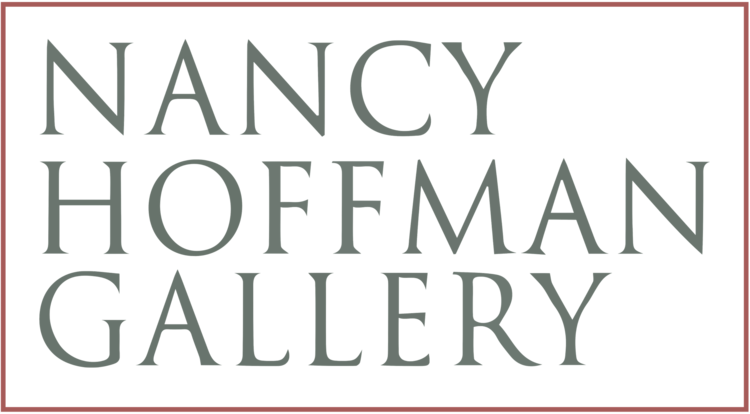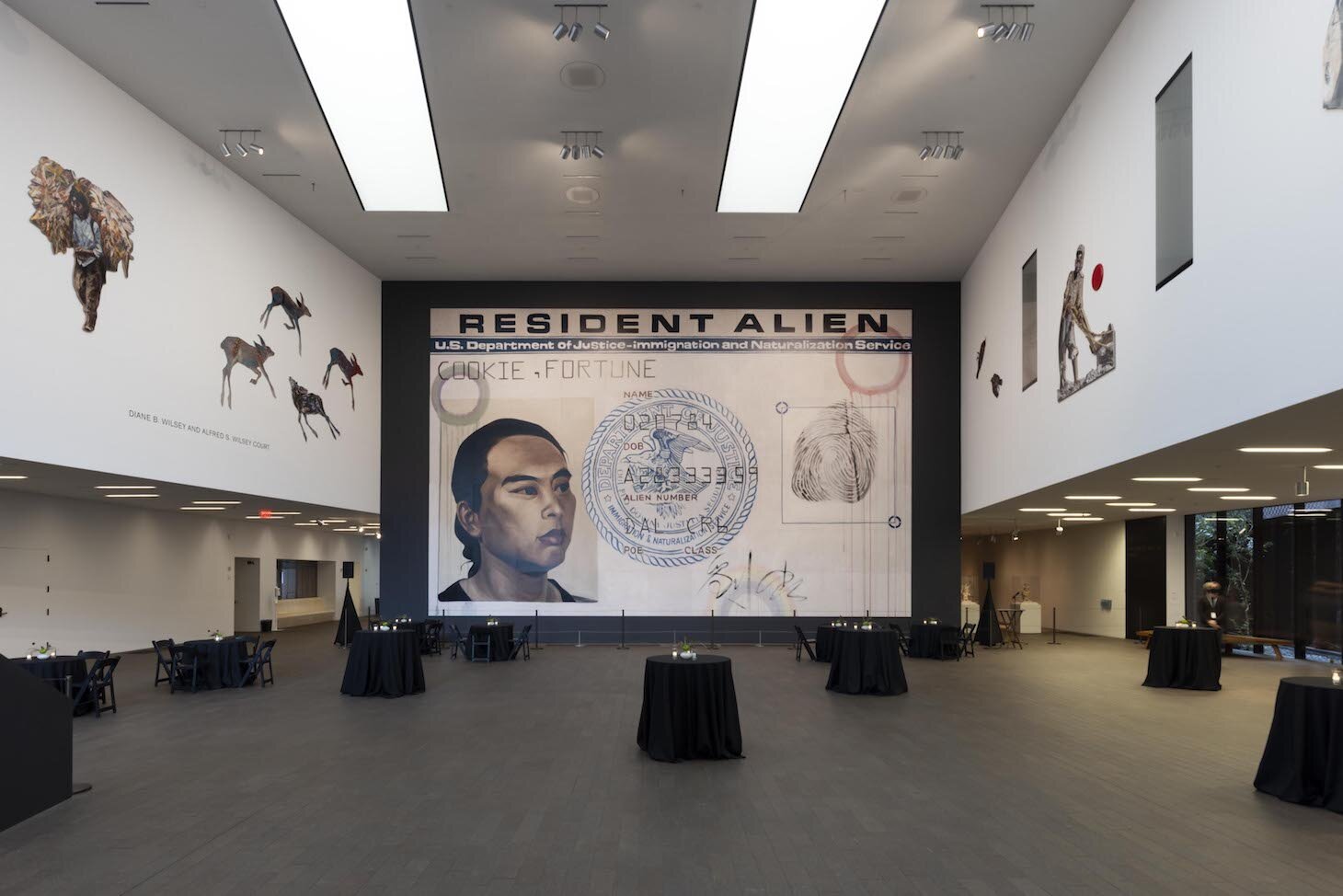A Final Show Honors the Legacy of a Bay Area Art Legend Hung Liu, an artist who “defied the stereotype that’s thrust on Asian women.”
by Emily Wilson
Opening of Hung Liu: Golden Gate (金門) at the de Young Museum in San Francisco (image courtesy the Fine Arts Museums of San Francisco, photo by Drew Altizer)
SAN FRANCISCO — “Resident Alien 2021” is the “brilliant linchpin” of Hung Liu’s solo show, Golden Gate (金門), at the de Young Museum, says curator Janna Keegan.
For the show, Liu updated this piece, which she first exhibited in 1988 at San Francisco’s Capp Street Project. Based on her green card, it takes up the whole back wall of the museum’s atrium, with “Cookie, Fortune” replacing her name, and the year of her birth changed from 1948 to 1984 — the year she moved to the United States.
The show, up through next March, explores migration, and is anchored by Liu’s story. Born in Changchun, China, the artist was sent to work in the countryside during the Cultural Revolution (1966–76) and studied mural painting at the Central Academy of Fine Arts in Beijing. She immigrated to the United States when she was 35 years old to get her MFA at the University of California, San Diego. Along with “Resident Alien,” the show includes “Chinese Shrimp Junk II” (1994), originally part of the exhibition Old Gold Mountain at the de Young (1994), which dealt with the histories of Chinese immigrants in California during the Gold Rush, before the 1882 Chinese Exclusion Act. Old Gold Mountain featured 200,000 fortune cookies heaped on top of railroad tracks.
Liu succumbed to pancreatic cancer at her home in Oakland on August 7, just a few weeks after the opening of Golden Gate (金門). She was 73.
Hung Liu: Golden Gate (金門) at the de Young Museum in San Francisco (image courtesy the Fine Arts Museums of San Francisco)
After the Chinese government cancelled Liu’s solo show at the UCCA Center for Contemporary Art in Beijing a month before it was scheduled to open in December 2019, officials at the de Young stepped in, hoping to exhibit the artist’s work. Due to complications of COVID-19 and other factors, organizing an exhibition in the museum’s regular galleries didn’t work. But Thomas Campbell, director of the Fine Arts Museums in San Francisco (which includes the de Young and the Legion of Honor), proposed installing it in the museum’s Wilsey Court, a public space.
Keegan and Liu came up with the theme of migration: works representing China are on one side of the space, while those representing America are on the other. “Hung refers to immigration as being a bridge, and this reflects the two cultures,” she notes.
The artist used linseed oil to blur images painted in the Social Realist style in which she was trained. Liu’s website states, in reference to her integration of watery washes and drips, that she “has invented a kind of weeping realism that surrenders to the erosion of memory and the passage of time.”
In addition to Liu’s style, Keegan appreciates the subjects her art highlights: “She looks at people who are normally elided from art. She has this empathy from growing up with the official narrative of what people said was going on and what she witnessed.”
Hung Liu, “Right & Left” (2013), in Hung Liu: Golden Gate (金門) at the de Young Museum in San Francisco (image courtesy the Fine Arts Museums of San Francisco)
In the last few years, Liu had been looking at photos of people taken during the Great Depression in the Dorothea Lange Archive at the Oakland Museum of California. Golden Gate (金門) includes “Girl with Sack” (2021) and “Cotton Picker” (2021), both reimagining Lange’s photographs through Liu’s weeping realism.
For the curator, working on this show had particular poignance: she and Liu met when Keegan worked in the front office of Oakland’s Mills College, where Liu taught painting for 20 years.
“I was in no way an important person, but she would take special time to come see me and talk to me about my research,” Keegan says. “When we were working on this show, she said to me, ‘I’m so proud of you!’ It warms your heart so much to have somebody legendary believe in you.”
Liu mentored many Bay Area artists, including Yulia Pinkusevich, who took her position when Liu retired from Mills.
“I was intimidated because she’s a massive figure here in the Bay Area, but I was really surprised by how warm and candid she was,” remembers Pinkusevich, who immigrated from Ukraine when the former Soviet Union collapsed. “I think she liked the fact that we both have this immigrant story and came to the United States to pursue our artistic dreams.”
Hung Liu, “Girl With Sack” (2021), in Hung Liu: Golden Gate (金門) at the de Young Museum in San Francisco (image courtesy the Fine Arts Museums of San Francisco)
When Pinkusevich took over the office from Liu, she found it all cleaned out — except for an old, broken chair. At first, she didn’t understand why Liu had left it.
“It turned out it was Jay de Feo’s chair who was her predecessor,” Pinkusevich says. “Hung saved it and showed her this respect, and I thought this gesture was very generous. She had a deep appreciation for people in her life and in her work.”
Liu made people feel special, Pinkusevich reflects.
Liu’s work and her consideration for others also meant a lot to artist Stephanie Syjuco, who studied at the San Francisco Art Institute in the 1990s. She says Liu was one of the first prominent Asian women artists she heard about, and one who reflected Syjuco’s reality.
“I think she understood her ability to bring people together,” Syjuco says. “She was so powerful too, and that was the coolest thing. She was nice and wonderful and warm, but she took no shit. She defied the stereotype that’s thrust on Asian women.”
Mark Dean Johnson, an art professor at San Francisco State University and an editor of Asian American Art: A History, 1850-1970, feels that Liu’s contribution to the Bay Area art scene is inestimable.
Hung Liu: Golden Gate (金門) at the de Young Museum in San Francisco (image courtesy the Fine Arts Museums of San Francisco)
“Her high spirits, international sophistication, and brilliant wit made every interaction a joy. Her courageously powerful and ambitious work, with its foundation in human rights and compassion for laborers, brought new relevance to social realism.”
Keegan calls Liu a rare character: “It was hard to meet Hung and not feel close to her.” Most of all, Keegan is grateful for a final chance to work with Liu. “I’m so pleased we got [Golden Gate (金門)] up and completed while Hung was still here,” she says, adding, “It’s a great legacy for her.”
Hung Liu: Golden Gate (金門) continues at the de Young Museum (50 Hagiwara Tea Garden Drive, San Francisco, California) through March 13, 2022. The exhibition is organized by Janna Keegan, Assistant Curator of Contemporary Art and Programming at the Fine Arts Museums of San Francisco.





